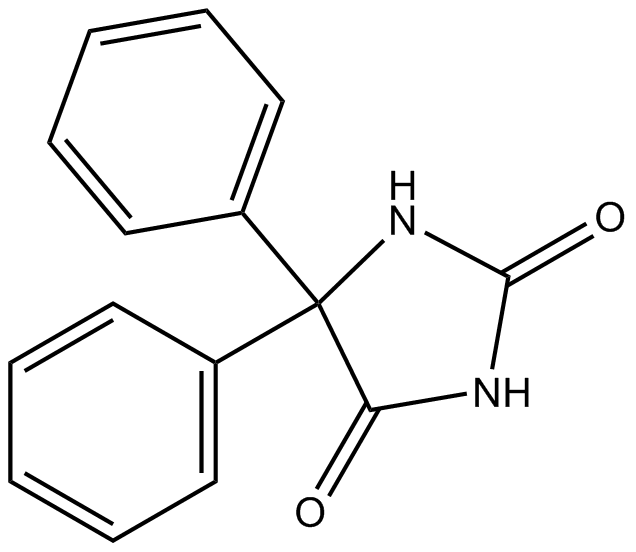Phenytoin (Synonyms: 5,5-Diphenylhydantoin, NSC 8722) |
| Catalog No.GC16086 |
inactive voltage-gated sodium channel stabilizer
Products are for research use only. Not for human use. We do not sell to patients.

Cas No.: 57-41-0
Sample solution is provided at 25 µL, 10mM.
Phenytoin is an inactive voltage-gated sodium channel stabilizer.Target: Sodium ChannelPhenytoin is an antiepileptic drug. It is useful to treat partial seizures and generalized tonic-clonic seizures but not primary generalized seizures such as absence seizures or myoclonic seizures. Phenytoin is believed to protect against seizures by causing voltage-dependent block of voltage-gated sodium channels [1]. Phenytoin has low affinity for resting sodium channels at hyperpolarized membrane potentials [2]. When neurons are depolarized and the channels transition into the open and inactivated states, greater binding and block occur. The inhibitory potency is strongly use dependent, so that block accumulates with prolonged or repetitive activation, such as occurs during a seizure discharge. The blocking of sodium channels by phenytoin is of slow onset. The time course of fast sodium currents is therefore not altered in the presence of the drug and action potentials evoked by synaptic depolarizations of ordinary duration are not blocked. Thus phenytoin is able to selectively inhibit pathological hyperexcitability in epilepsy without unduly impairing ongoing activity. Phenytoin also blocks persistent sodium current and this may be of particular importance in seizure control. Phenytoin is a class 1b antiarrhythmic [3].
References:
[1]. Rogawski, M.A. and W. Loscher, The neurobiology of antiepileptic drugs. Nat Rev Neurosci, 2004. 5(7): p. 553-64.
[2]. Porter, R.J., et al., Mechanisms of action of antiseizure drugs. Handb Clin Neurol, 2012. 108: p. 663-81.
[3]. Balaji, S., Medical therapy for sudden death. Pediatr Clin North Am, 2004. 51(5): p. 1379-87.
Average Rating: 5 (Based on Reviews and 9 reference(s) in Google Scholar.)
GLPBIO products are for RESEARCH USE ONLY. Please make sure your review or question is research based.
Required fields are marked with *




















